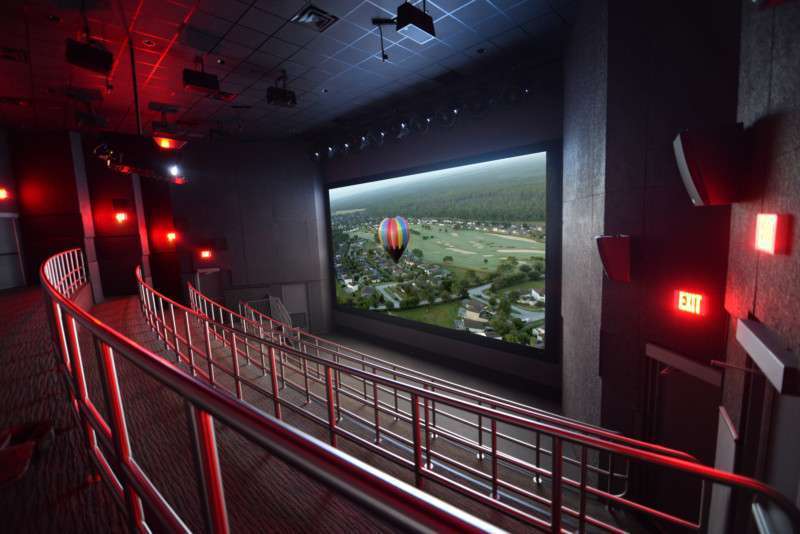The Golden Rule of theme park technology
by Scott Harkless, Chief Innovation Officer, Alcorn McBride
Before I was fortunate enough to fall into this industry, I worked in one of those big box technology stores. As an engineering student with an affinity for technology, I remember being fascinated by the gimmicks manufacturers would use to lure consumers into spending more money. One example I’ll never forget was Sony’s top-of-the-line CRT TV called the WEGA. In the late 1990s, this was the only TV to offer a flat screen (instead of the domeshaped screen most CRT televisions had). This slight improvement came at a high cost, though – and I’m not just talking about money.
This 36” behemoth weighed a hernia-inducing 223-pounds. One night I was unloading one of the supply trucks when an unfortunate shift in cargo resulted in a revelation that can only be brought on by a 223-pound TV striking you square in the face. As I came to, bloody and battered on the floor of a trailer, I remember thinking… ‘is this really what people want? I find it hard to believe that someone is going to take this thing home and say, “It took a herniated disc and a reinforced concrete TV-stand – but check out the flat corners on that picture!”’
While technology has certainly come a long way in the 20 years since, I still see plenty of examples of people getting caught up in the idea that amazing new technologies drive great experiences. If I have learned anything from this industry, it’s that the complete opposite is true. It is the desire to create great experiences that drives amazing new technologies. For me, this has become a golden rule that influences everything I do.
As we kick off 2018, we’re all wondering what lies around the corner for our industry. As a technology professional, I try to keep tabs on technical progress and I’m pretty sure that time machines are still on the drawing board. While I wait for my flux capacitor to arrive, I just try to keep in mind what makes the most successful themed attractions special: the ability to transplant guests to an alternate reality.
The more immersive the experience, the more “real” it feels and the more likely it will be enjoyed. There was a time that I might have referred to an immersive experience as a “virtual reality,” but those pesky technology gimmicks I mentioned are forcing me to reconsider that terminology (sorry, VR fans). We build these alternate realities from physical things like stone, plants, sounds, visual effects, smells, animals, robotic figures, costumes, human beings, and anything else that makes the experience feel as real and immersive as possible. We also consider the social aspect of including friends and family in these experiences, because our fondest memories always involve people we care about.
With that foundation in mind, I believe that making these social and physical experiences even more immersive is the future of theme parks. People don’t just want to go on a five-minute ride based on their favorite story; they want to spend an entire day, or maybe even their entire vacation, living in that experience. They want to interact with objects and characters from the story, dress like them, feel powerful like them, and anything else that makes them feel like that story is real and that they are part of it. Remembering the golden rule, this is the path that I believe will drive incredible new theme park technologies.
I don’t have enough battery life left in my laptop to go into all of the areas where I anticipate these advancements, but I’d like to focus on the ones I feel will play the largest role: interactivity, personalization, and inclusion.
Interactivity
Let’s start off with interactivity. Seeing an object from your favorite story glued to a shelf is nice, but physically interacting with that object in a meaningful way can take the experience to a whole new level. Having that object move, make sounds, light up, and react to proximity or touch can easily enhance the guest’s experience when done effectively.
To use a generic example that won’t provoke a lawsuit, my four-year-old son is obsessed with dinosaurs. He gets a big smile on his face just from seeing fiberglass dinosaur statues. That being said, I can only imagine how much it would mean to him to interact with a dinosaur figure that actually moved, breathed, made sounds and reacted to his presence. His big smile would transform into giggling bliss if a Velociraptor leaned down and snorted in his face. Let’s not kid ourselves, though. Making things that are non-existent (or extinct in this case) come to life isn’t easy! It’s going to require continuous improvements in animatronics, puppeteering, costume design, special effects and sensor technologies by people who are devoted to those pursuits.
Personalization
Personalization will also play a key role in our future. There’s a trend in giving guests the opportunity to buy a unique object (perhaps a bracelet or elegantly themed stick?) to carry with them. The idea is that they use this item throughout the day to interact with the themed world around them. When done well, the guests feel a personal connection to the item and the unique way in which their environment reacts to them.
Advances in portable electronics, wireless communications, and database technologies will no doubt lead to these experiences being even more personal. To continue with my lawsuit-safe example, I imagine my son unearthing a Velociraptor claw at a dig site. Using RFID or other near-field identification technologies within the item, the characters and attractions would know him as “Daniel – World-Famous Velociraptor Hunter” and personalize their interactions with him. His prized discovery might even get him access to special areas like the paleontologist club, or access to special treats reserved for hungry excavators. When his day is over, he gets to go home with a souvenir that reminds him of the time when he discovered something incredible and was rewarded with a unique experience. There are countless examples of how this type of personalization tech can be used, but I can’t imagine a better way to draw guests deeper into an experience.
Inclusion
Inclusion will also play a key role in the experiences we create. We live in a global society. Many languages are spoken. Many people have special needs. These are areas where new technologies offer the opportunity to include more guests in the experience. For example, devices like smart glasses can now be worn by guests to see personalized captions for attractions or park areas. Identification items such as wristbands could interact with ride vehicles so that the audio in the seats plays in the guest’s language. This could bring dramatic new levels of inclusiveness to a guest experience. Again, the possibilities here are endless and much more achievable with the technologies we’ve been developing with these experiences in mind.
It’s no coincidence that there’s a great deal of overlap in the areas I’ve mentioned, and I hope the reason is obvious. When done properly, the technologies we develop to make attractions more interactive, personalized and inclusive all coalesce to form a single memorable experience for guests and their loved ones. Whether your interests lie in the creative or technological aspects of attraction design, within our industry we all share the same goal of making those experiences as memorable as possible.
When it comes to daily life, many of us are aware that technology often stands in the way of having meaningful interactions with other people and the world around us. With the alternate realities we create, we have a unique opportunity to apply technology in the exact opposite manner; to immerse guests and their loved ones in a world they can experience and enjoy together. • • •
PHOTO: The Orlando Eye preshow in Orlando, Florida utilizes Alcorn McBride equipment. Courtesy of Alcorn McBride.
 As Chief Innovation Officer at Alcorn McBride, Scott Harkless works closely with clients to determine their biggest areas of need and leads a talented team of problem solvers to create the products used in many of the world’s most popular attractions. He draws upon his experience in product development, system commissioning, client training, marketing, and sales to ensure that the products stamped with the Alcorn McBride logo exceed client expectations and offer value to the entire industry.
As Chief Innovation Officer at Alcorn McBride, Scott Harkless works closely with clients to determine their biggest areas of need and leads a talented team of problem solvers to create the products used in many of the world’s most popular attractions. He draws upon his experience in product development, system commissioning, client training, marketing, and sales to ensure that the products stamped with the Alcorn McBride logo exceed client expectations and offer value to the entire industry.






